Australian Reptiles, large and small
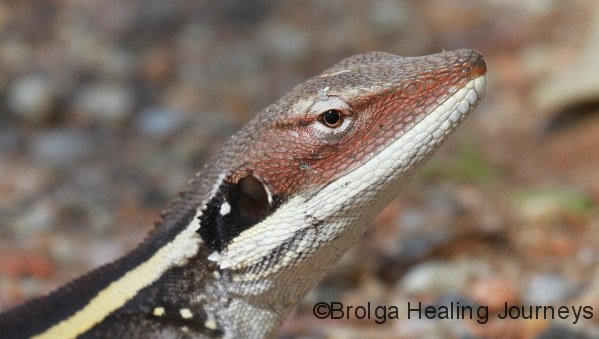
We began our journey with little appreciation of Australia’s reptiles. We knew the names of a few poisonous snakes, could probably recognise a Goanna, or a Frill-necked Lizard, and maybe one or two others, but that was about it Oh, and we knew to avoid Crocodiles (see previous post).
Little did we realise that Australia has incredible herpetological riches. At the latest count Australia was home to 864 species of reptile, though this number is constantly rising as new species are discovered. We hope that environmental degradation doesn’t push the number downwards.
Australia has over 370 species of Skinks alone. Our Skinks range from larger members such as the well-known Blue Tongued Lizard, to some quite exotic, colourful little creatures hiding in rock crevices in the least hospitable regions of the country. They tend to be sleek, shiny creatures that scuttle off at the first sign of a larger creature such as a human.
What we loosely call the Goanna actually encompasses around 50 species of Goannas and Monitors across the country, ranging from the very large, such as the Perentie (up to 2.4 metres long), to the very small, such as the Short-Tailed Pygmy Monitor (23cm).
We have many ’Dragons’ roaming our country, though these are not the fire-breathing Dragons of European legend. They come in an amazing range of colours and shapes. The Frilled (or Frill-Necked) Lizard is one, and another is the Thorny Devil, a bizarre looking little creature that, despite its name, eats only ants. We saw some quite amazingly camouflaged Dragons as we travelled around the rocky Pilbara, Kimberley and central parts of the country.
Australia also is home to many beautiful Geckos, most of which are nocturnal and therefore seldom seen.
And of course, we have our snakes. We take a certain national pride in telling overseas visitors about the sheer range of venomous snakes lurking in the Australian bush. We have 9 out of 10 of the world’s most venomous, or was it 19 out of 20. It doesn’t matter, one of them is certain to get you. In fact, the poor old snake has had an undeservedly bad reputation since Biblical times. You can be unlucky, but most of the time snakes are more afraid of you, than you of them. Treat them with caution and respect, basically leave them alone, and you will probably be fine. In fact, given their numbers in the bush, it is unusual to see a snake, because they slither off to safety as soon they feel the vibrations of your movement through the bush.
Despite their shyness, we have seen a few snakes during our bush-walks. I began our travels with a fear of snakes bordering on the phobic, and while I would still not class them as my favourite creatures, I have come to respect them and admire their beauty. I have had several close encounters with snakes during our travels, and am relieved to report that none of the snakes were aggressive. My closest contact was in the Warren National Park in the south west of WA. I was walking on a bush track and felt some resistance against my foot. Looking down, I realised that a Dugite (a potentially deadly WA member of the Brown Snake family) was crossing the track and had come into contact with my foot. The trees in the Warren National Park are a Eucalypt known as the Karri, and grow to some 75 metres tall. I leaped so high that day I was able to enjoy the view from above the canopy!
Finally, we recently heard some enlightening information about reptiles, at the Alice Springs Desert Park. We are all led to believe that reptiles are ‘cold-blooded’ creatures. Now, this may be correct in the sense that they are unable to maintain a blood temperature within strict bounds, as do, say, mammals like us. But you would be just as correct to consider reptiles as solar powered, and not cold blooded. Reptiles obtain around 80% of their energy from the heat of the sun, and only require around 20% of their energy from food. We, of course, need 100% of our energy from food. So, when you think about it, they need only one-fifth of the food we need in order to survive.
We hope you enjoy the following galleries. Given the sheer numbers of species involved, we have only named those we are (fairly) sure about. The task of matching scientific names to photographs is something we will undertake on a future rainy day.
GOANNAS AND MONITORS
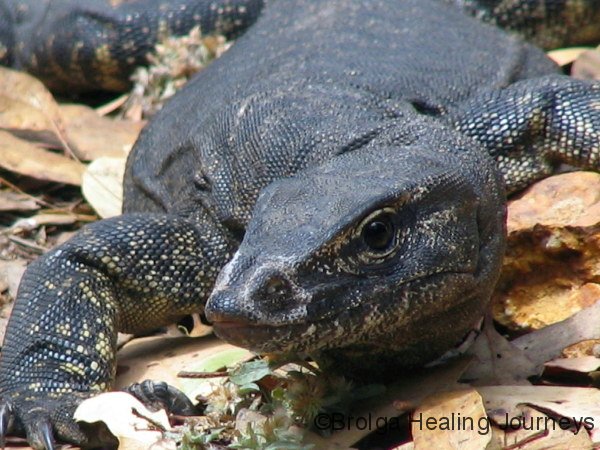
It is always a thrill to see one of these beautiful creatures in the wild but, we must admit, always a little frightening too. Some of them are huge, and they are extremely fast when they want to be!
DRAGONS
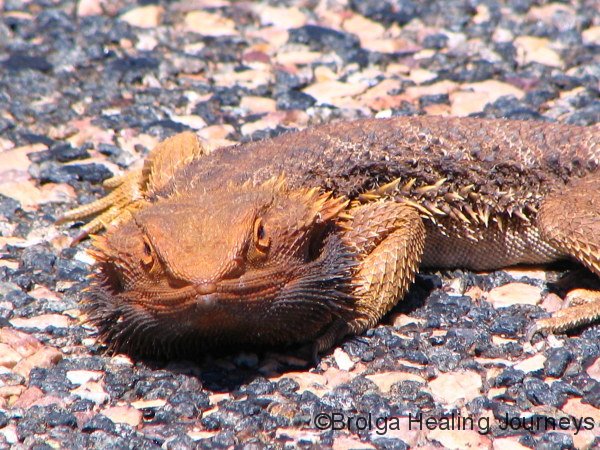
We love these lizards. They have some of the most incredible camouflage we have seen (and many, no doubt, we haven’t). And they are wonderful to photograph – one of their defence mechanisms is to stay perfectly still; a dream for any wildlife photographer.
All of the photographs were taken in the wild, except for those of the Thorny Devils, which were taken at the Alice Springs Reptile Centre. We have tried in vain, to date, to see these beautiful little devils in the wild. They live in sand-dune country and shelter under Spinifex clumps. They really don’t live up to their name, because all they eat are ants (up to 5000 in a meal) and are harmless to humans. Their thorny skin not only serves as camouflage and protection - it is also an ingenious evolutionary invention that channels any moisture falling on the skin to the mouth of the lizard. That is quite mindblowing really.
Since the Kalbarri district of WA, we have encountered many Long-Nosed Dragons. Whoever named these lizards needs a whack on their long nose, because anyone looking at these lizards is immediately struck by the incredible length of their tails – up to three times the length of their body. You hardly notice their nose.
SKINKS
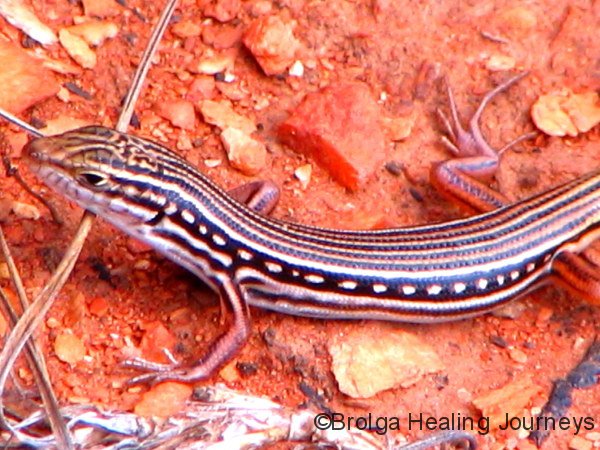
As we said, Australia is home to hundreds of species of Skink, many of which appear very similar. We can identify some Blue Tongues, the Shingleback, and the King’s Skink (a large, chunky Skink from the Nullarbor coast and southern coast of WA), but that’s about it. We’ll do our best to name the others as we go along.
GECKOS
We had a Gecko stowaway in our car for a week or so in Alice Springs, and are happy to report that we released it safely. We hope to add more photos of these beautiful lizards as we go.
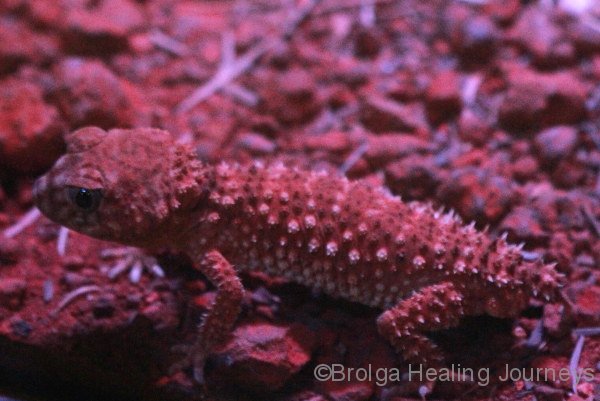
LEGLESS LIZARDS
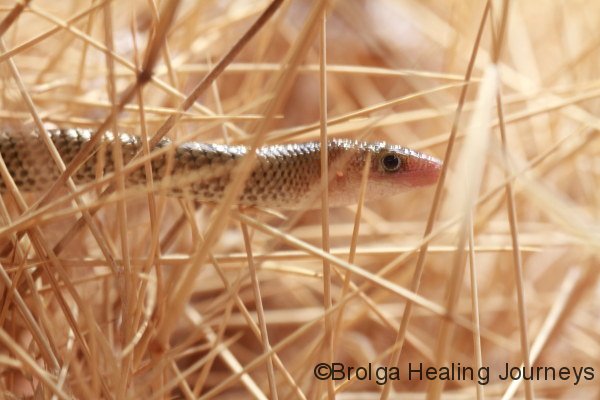
Australia is home to many of these lizards, which are often mistaken for small, slender snakes. They are distinguishable from snakes by the presence of their ear-openings, thicky fleshy tongue rather than the slender forked tongue of the snake, and tails longer than their body.
SNAKES
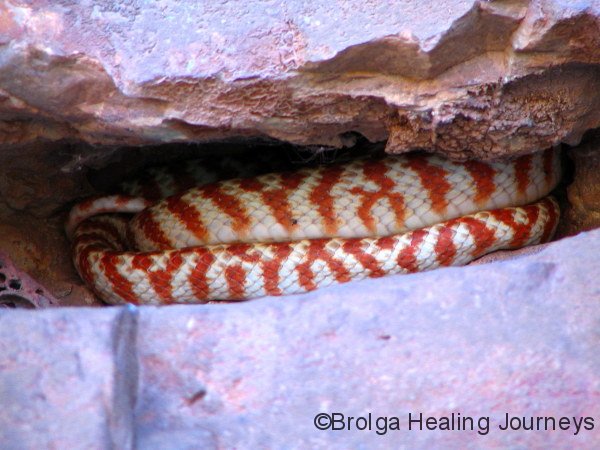
We don’t have a huge number of snake photographs, because I am usually too interested in self preservation to worry about photos. Anyway, here’s what we have:















































































